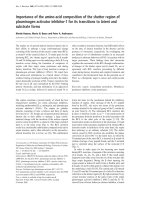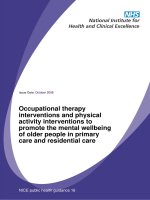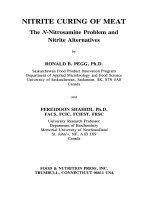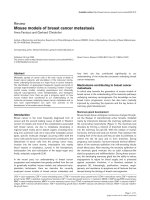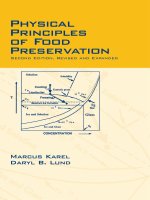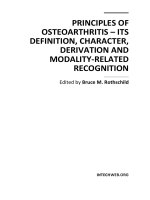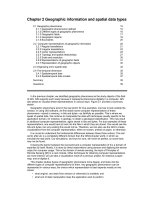PRINCIPLES OF OSTEOARTHRITIS – ITS DEFINITION, CHARACTER, DERIVATION AND MODALITY-RELATED RECOGNITION pdf
Bạn đang xem bản rút gọn của tài liệu. Xem và tải ngay bản đầy đủ của tài liệu tại đây (47.98 MB, 602 trang )
PRINCIPLES OF
OSTEOARTHRITIS – ITS
DEFINITION, CHARACTER,
DERIVATION AND
MODALITY-RELATED
RECOGNITION
Edited by Bruce M. Rothschild
Principles of Osteoarthritis – Its Definition,
Character, Derivation and Modality-Related Recognition
Edited by Bruce M. Rothschild
Published by InTech
Janeza Trdine 9, 51000 Rijeka, Croatia
Copyright © 2012 InTech
All chapters are Open Access distributed under the Creative Commons Attribution 3.0
license, which allows users to download, copy and build upon published articles even for
commercial purposes, as long as the author and publisher are properly credited, which
ensures maximum dissemination and a wider impact of our publications. After this work
has been published by InTech, authors have the right to republish it, in whole or part, in
any publication of which they are the author, and to make other personal use of the
work. Any republication, referencing or personal use of the work must explicitly identify
the original source.
As for readers, this license allows users to download, copy and build upon published
chapters even for commercial purposes, as long as the author and publisher are properly
credited, which ensures maximum dissemination and a wider impact of our publications.
Notice
Statements and opinions expressed in the chapters are these of the individual contributors
and not necessarily those of the editors or publisher. No responsibility is accepted for the
accuracy of information contained in the published chapters. The publisher assumes no
responsibility for any damage or injury to persons or property arising out of the use of any
materials, instructions, methods or ideas contained in the book.
Publishing Process Manager Vana Persen
Technical Editor Teodora Smiljanic
Cover Designer InTech Design Team
First published February, 2012
Printed in Croatia
A free online edition of this book is available at www.intechopen.com
Additional hard copies can be obtained from
Principles of Osteoarthritis – Its Definition,
Character, Derivation and Modality-Related Recognition, Edited by Bruce M. Rothschild
p. cm.
978-953-51-0063-8
Contents
Preface IX
Part 1 Overview of Osteoarthritis 1
Chapter 1 Epidemiology and
Biomechanics of Osteoarthritis 3
Bruce M. Rothschild and Robert J. Woods
Chapter 2 Symptoms, Signs and
Quality of Life (QoL) in Osteoarthritis (OA) 25
Keith K.W. Chan and Ricky W.K. Wu
Part 2 Imaging 41
Chapter 3 An Atlas-Based Approach to Study Morphological
Differences in Human Femoral Cartilage Between
Subjects from Incidence and Progression Cohorts:
MRI Data from Osteoarthritis Initiative 43
Hussain Tameem and Usha Sinha
Chapter 4 The Application of Imaging in Osteoarthritis 65
Caroline B. Hing, Mark A. Harris,
Vivian Ejindu and Nidhi Sofat
Chapter 5 Biomarkers and Ultrasound in
the Knee Osteoarthrosis Diagnosis 89
Sandra Živanović, Ljiljana Petrović Rackov and Zoran Mijušković
Part 3 Biomechanics 111
Chapter 6 Biomechanics of Physiological
and Pathological Bone Structures 113
Anna Nikodem and Krzystof Ścigała
Chapter 7 Subchondral Bone in Osteoarthritis 139
David M. Findlay
VI Contents
Chapter 8 The Relationship Between Gait Mechanics and
Radiographic Disease Severity in Knee Osteoarthritis 155
Ershela L. Sims, Francis J. Keefe, Daniel Schmitt,
Virginia B. Kraus, Mathew W. Williams, Tamara Somers,
Paul Riordan and Farshid Guilak
Chapter 9 Osteoarthritis in Sports and Exercise:
Risk Factors and Preventive Strategies 173
Eduard Alentorn-Geli and Lluís Puig Verdié
Chapter 10 Post-Traumatic Osteoarthritis:
Biologic Approaches to Treatment 233
Sukhwinderjit Lidder and Susan Chubinskaya
Part 4 Genetics 261
Chapter 11 The Genetics of Osteoarthritis 263
Antonio Miranda-Duarte
Chapter 12 Genetic Association and
Linkage Studies in Osteoarthritis 285
Annu Näkki, Minna Männikkö and Janna Saarela
Chapter 13 Genetic Mouse Models for Osteoarthritis Research 321
Jie Shen, Meina Wang,
Hongting Jin, Erik Sampson and Di Chen
Part 5 Metabolic 335
Chapter 14 Cartilage Extracellular Matrix Integrity and OA 337
Chathuraka T. Jayasuriya and Qian Chen
Chapter 15 Biochemical Mediators Involved in Cartilage
Degradation and the Induction of Pain in Osteoarthritis 367
Michael B. Ellman, Dongyao Yan, Di Chen and Hee-Jeong Im
Chapter 16 Proteases and Cartilage Degradation in Osteoarthritis 399
Judith Farley, Valeria M. Dejica and John S. Mort
Chapter 17 Simple Method Using Gelatin-Coated
Film for Comprehensively Assaying
Gelatinase Activity in Synovial Fluid 419
Akihisa Kamataki, Wataru Yoshida, Mutsuko Ishida,
Kenya Murakami, Kensuke Ochi and Takashi Sawai
Chapter 18 Toll-Like Receptors: At the Intersection
of Osteoarthritis Pathology and Pain 429
Qi Wu and James L. Henry
Contents VII
Chapter 19 Anion Channels in Osteoarthritic Chondrocytes 445
Elizabeth Perez-Hernandez, Nury Perez-Hernandez,
Fidel de la C. Hernandez-Hernandez and Juan B. Kouri-Flores
Chapter 20 The Cholinergic System Can Be of
Unexpected Importance in Osteoarthritis 461
Sture Forsgren
Chapter 21 Transcriptional Regulation of Articular Chondrocyte
Function and Its Implication in Osteoarthritis 473
Jinxi Wang, William C. Kramer and John P. Schroeppel
Chapter 22 TGF- Action in the Cartilage in Health and Disease 497
Kenneth W. Finnson, Yoon Chi and Anie Philip
Part 6 Cellular Aspects of Osteoarthritis 517
Chapter 23 How Important are Innate
Immunity Cells in Osteoarthritis Pathology 519
Petya Dimitrova and Nina Ivanovska
Chapter 24 The Role of Synovial Macrophages and
Macrophage-Produced Mediators in Driving Inflammatory
and Destructive Responses in Osteoarthritis 545
Jan Bondeson, Shane Wainwright,
Clare Hughes and Bruce Caterson
Chapter 25 Cellular Physiology of Articular
Cartilage in Health and Disease 567
Peter I. Milner, Robert J. Wilkins and John S. Gibson
Preface
The inevitability of a disease sounds a clarion for its prevention, or at least its control.
Understanding its pathophysiology is essential to that process. For osteoarthritis,
preconceived notions and mythology must be transcended to allow identification of its
essentials. The first step was to establish a scientific basis for its recognition. Sorting
associated phenomenon allowed identification of those which are non-diagnostic, and
one major finding which is pathognomonic: the joint osteophyte. Once that was
distinguished from the asymptomatic vertebral body, osteophytes identifying
spondylosis deformans, a major impediment to disease understanding, was
eliminated. While animal models have been sought or manufactured to address the
question, this new understanding afforded a new perspective. There is a major
dichotomy between the frequency of osteoarthritis in wild-caught and captive animals.
The former were seldom afflicted, while the latter commonly develop osteoarthritis.
The commonality with the human condition is the artificiality of the environments that
we share to varying degrees. Transformation from an arboreal to a terrestrial habitat,
alteration of ground conditions, alteration of gait, and design of footwear are a few of
the factors to consider.
This work is divided into sections on the basis of epidemiology, biomechanics, altered
morphology and its imaging, biochemistry, immunology, genetic contributions,
environmental and sports-related trauma, and quality of life. The question of primacy
of cartilage or bone in the induction of osteoarthritis is reviewed, examining also the
role of synovial and other extra-osseous, extra-cartilaginous tissues. Recognizing
osteoarthritis and alteration in joint morphology and kinesiology and their interactions
is explored.
Osteoarthritis has variably been referred to as a non-inflammatory and as an
inflammatory form of arthritis. The latter perspective seems to derive from the
apparent role of inflammation and immune response in wound healing. Therefore, the
role of mediators of healing, inflammation, and modulators of immune response are
reviewed. The role of the nervous system in development and progression of
osteoarthritis is explored. Absence of certain nerve functions (e.g. position sense) leads
to accelerated joint damage (a neuropathic joint), while cholinergic effectors may also
contribute to joint damage.
X Preface
Epidemiological studies afford the opportunity to identify possible factors which
mitigate the occurrence or severity of osteoarthritis. Genetic analyses suggest possible
vectors and genetic models allow the resultant hypotheses to be tested. Their use
obviates the need to create artificial surgical models of disease. The inherent role of
joint instability can be directly evaluated, rather than artificially produced instability.
The latter perhaps directly models osteoarthritis related to trauma.
Trauma modifies tissue relationships, creating an artificial state which may itself be a
major factor in development of osteoarthritis. So, too, it is with sports. Inherent in
many sports activities is joint trauma, and training often includes efforts to allow the
body to accept more punishment. “Work hardening” may predispose to osteoarthritis,
as may injudicious training programs. Optimizing training to increase the rate and
level of preparation for sports must be individed. Nonetheless, it carries risk of injury
and precipitation of osteoarthritis. The resultant quality of life often reflects the care
taken during those life events.
Osteoarthritis is the most common disease affecting humans. It has been suggested
that the only reason the entire human population is not afflicted is because we die too
soon. As life expectancy is extended, the prevalence of osteoarthritis can be expected
to increase. Osteoarthritis appears to be the inevitable result of the human condition,
or at least as it exists today. Understanding its nature and contributing factors may
allow prevention. Redesign of walking surfaces and initiation of exercise programs
oriented to maintenance of joint stability have seen reasonable recommendations to
start that process. Understanding the nature and character of osteoarthritis should
facilitate its control and perhaps prevention. This book specifically examines
opportunities for intervention in the process. Medicinal applications are a subject for a
second volume.
Dr. Bruce Rothschild
Professor of Medicine, The Northeastern Ohio Universities, College of Medicine,
Director, Arthritis Center NEO,
USA
Part 1
Overview of Osteoarthritis
